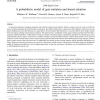Free Online Productivity Tools
i2Speak
i2Symbol
i2OCR
iTex2Img
iWeb2Print
iWeb2Shot
i2Type
iPdf2Split
iPdf2Merge
i2Bopomofo
i2Arabic
i2Style
i2Image
i2PDF
iLatex2Rtf
Sci2ools
119
Voted
NN
2006
Springer
2006
Springer
A probabilistic model of gaze imitation and shared attention
An important component of language acquisition and cognitive learning is gaze imitation. Infants as young as one year of age can follow the gaze of an adult to determine the object the adult is focusing on. The ability to follow gaze is a precursor to shared attention, wherein two or more agents simultaneously focus their attention on a single object in the environment. Shared attention is a necessary skill for many complex, natural forms of learning, including learning based on imitation. This paper presents a probabilistic model of gaze imitation and shared attention that is inspired by Meltzoff and Moore's AIM model for imitation in infants. Our model combines a probabilistic algorithm for estimating gaze vectors with bottom-up saliency maps of visual scenes to produce maximum a posteriori (MAP) estimates of objects being looked at by an observed instructor. We test our model using a robotic system involving a pan-tilt camera head and show that combining saliency maps with gaz...
Related Content
| Added | 14 Dec 2010 |
| Updated | 14 Dec 2010 |
| Type | Journal |
| Year | 2006 |
| Where | NN |
| Authors | Matthew W. Hoffman, David B. Grimes, Aaron P. Shon, Rajesh P. N. Rao |
Comments (0)

